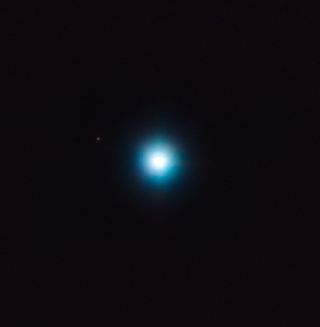
A jaw-dropping new photo shows a probable alien planet orbiting a star that lies 1,200 light-years from Earth.
The potential planet appears as a brownish dot to the left of the bright bluish-white star CVSO 30 in the newly released image, which was captured by the European Southern Observatory's (ESO) Very Large Telescope in Chile.
To appreciate just how fantastic it is to have a direct image of this candidate world, consider that CVSO 30 is about 280 times farther away from Earth than is Alpha Centauri, the star system nearest to our own. [Alien Planet Quiz: Are You an Exoplanet Expert?]
And remember also that 1 light-year is about 5.9 trillion miles (9.5 trillion kilometers). So the newly photographed world, known provisionally as CVSO 30c, is about 7 quadrillion miles (11 quadrillion km) away (in the direction of the constellation Orion, for what it's worth).
CVSO 30c remains a candidate planet, awaiting confirmation by follow-up observations or analysis. If it does indeed exist, the planet circles the star at a whopping distance of 660 astronomical units (AU), completing one orbit every 27,000 years, researchers said. (One AU is the Earth-sun distance — about 93 million miles, or 150 million km).
Astronomers spotted another planet candidate, CVSO 30b, around the same star back in 2012 via the "transit method," which looks for the tiny brightness dips caused when orbiting planets cross their host stars' faces.
Both potential alien worlds are gas giants, like Jupiter and Saturn. But they occupy very different spaces; CVSO 30b, if it exists, completes one orbit every 11 hours and lies just 0.008 AU from the star, astronomers said.
Get the Space.com Newsletter
Breaking space news, the latest updates on rocket launches, skywatching events and more!
"If it is confirmed that CVSO 30c orbits CVSO 30, this would be the first star system to host both a close-in exoplanet detected by the transit method and a far-out exoplanet detected by direct imaging," ESO representatives wrote in a description of the new image.
"Astronomers are still exploring how such an exotic system came to form in such a short timeframe, as the star is only 2.5 million years old; it is possible that the two planets interacted at some point in the past, scattering off one another and settling in their current extreme orbits," they added.
Direct imaging has been used to discover just a handful of alien planets to date. (Most of the 3,300-odd confirmed alien worlds have been found via the transit method, by NASA's Kepler space telescope.) But direct imaging promises to be more productive in the near future as technology improves, and may even provide the first convincing evidence of alien life, some astronomers have said.
The study reporting the detection of CVSO 30c — which relied on observations by the Keck Observatory in Hawaii and the Calar Alto Observatory in Spain in addition to the Very Large Telescope (VLT) — has been accepted for publication in the journal Astronomy & Astrophysics. You can read it online for free here: http://www.eso.org/public/archives/releases/sciencepapers/potw1624/potw1624a.pdf
The VLT, part of ESO's Paranal Observatory, consists of four individual telescopes, each of which has a main mirror that's 26.9 feet (8.2 meters) wide.
Follow Mike Wall on Twitter @michaeldwall and Google+. Follow us @Spacedotcom, Facebook or Google+. Originally published on Space.com.
Join our Space Forums to keep talking space on the latest missions, night sky and more! And if you have a news tip, correction or comment, let us know at: community@space.com.

Michael Wall is a Senior Space Writer with Space.com and joined the team in 2010. He primarily covers exoplanets, spaceflight and military space, but has been known to dabble in the space art beat. His book about the search for alien life, "Out There," was published on Nov. 13, 2018. Before becoming a science writer, Michael worked as a herpetologist and wildlife biologist. He has a Ph.D. in evolutionary biology from the University of Sydney, Australia, a bachelor's degree from the University of Arizona, and a graduate certificate in science writing from the University of California, Santa Cruz. To find out what his latest project is, you can follow Michael on Twitter.
